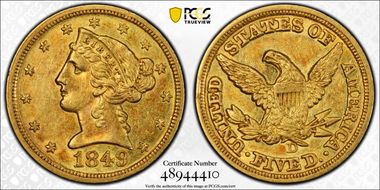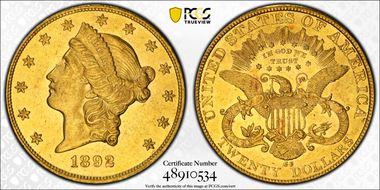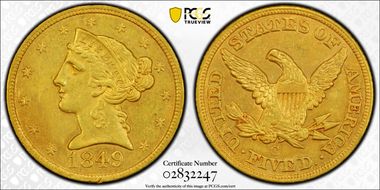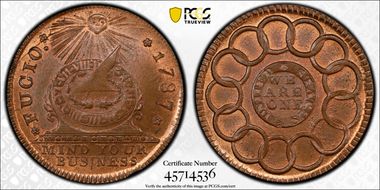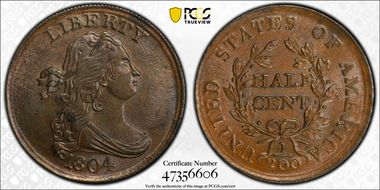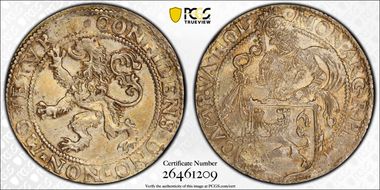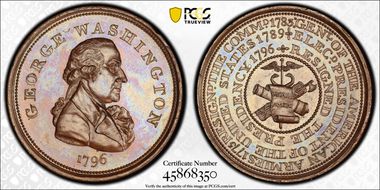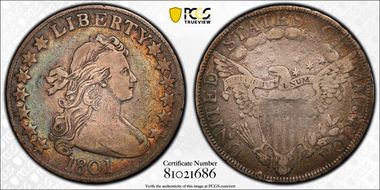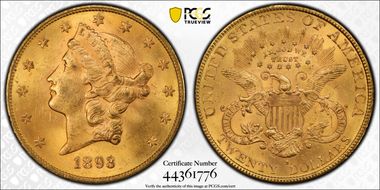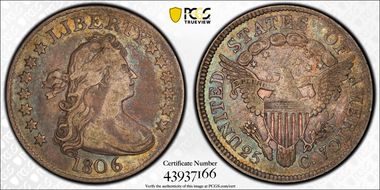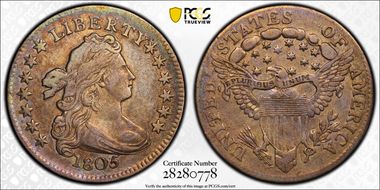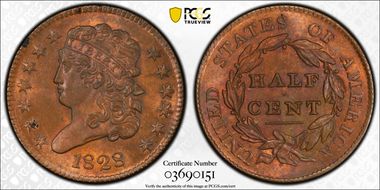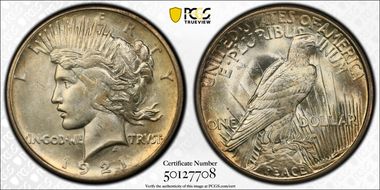My Top 20 Coins by Value 的展示图片库
$7,000 + $120 shipping + sales tax The 1849-D half eagle is very similar in rarity to the 1848-D. Like the 1848-D, it is a coin whose true rarity (especially in high grades) has not yet been fully acknowledged. The 1849-D half eagle is usually found in Very Fine to Extremely Fine grades. It is sometimes seen in About Uncirculated-50 but it is quite rare in any About Uncirculated grade above this. In full Mint State, the 1849-D is an extremely rare coin. STRIKE: The 1849-D is one of the last half eagles from this mint which can be consistently found with an acceptable strike. Most have better overall definition on the obverse than on the reverse. The area on the obverse which is most likely to show weakness is the curls below IBER in LIBERTY. The rest of the detail is usually sharp, including the stars and denticles. The reverse is often somewhat weak on the tips of the wing, the lower part of the neck and the right leg and claw. SURFACES: A number are known which show mint-made areas of granularity. Most are heavily marked but it is possible to locate an 1849-D half eagles which is not covered with detracting abrasions. LUSTER: The luster tends to be frosty in texture. A few are known which are slightly reflective in the fields. COLORATION: Original, uncleaned pieces show coloration which ranges from medium green-gold to deep orange-gold. Most have been cleaned or dipped and no longer show original coloration. EYE APPEAL: Compared to some of the other Dahlonega half eagles of the 1840’s, the 1849-D shows above average eye appeal. There are a number of well struck, attractive examples in existence. PERSONAL OBSERVATIONS: The 1849-D half eagle is a reasonably common coin in most circulated grades but it is extremely rare in Uncirculated. As with the similarly dated quarter eagle, it may be overlooked due to the 1849-D gold dollar being fairly available in Uncirculated. DIE VARIETIES: Three die varieties are currently known. Variety 21-N: On obverse, the date is not as well centered as on the next variety and is positioned higher in relation to the neck. The reverse is the same as described for Variety 19-N, except that there is absolutely no trace of the mispunched mintmark. It is not known which of the two 1849-D half eagle varieties is rarer. Variety 22-L: On the obverse, the date is well centered in the space between the neck and the denticles. The reverse has a high mintmark that touches both the stem and the feather. The left edge of the mintmark is over the center of the right diagonal of the V in FIVE. Variety 22-N: This is a newly discovered variety that combines the obverse and reverse dies listed above. It appears to be very rare. This is a very rare date in all grades, more so than the D Mint coins from 1843 to 1847 and roughly comparable to the 1848-D and 1850-D. It is much more rare as a date than the 1851-D, 1852-D, 1853-D and 1854-D and it has actually had fewer auction appearances than some of the
The 1892-CC is a scarce but not rare coin. It is a little more rare than the lower mintage 1893-CC in terms of population rarity and it is considerably more rare than the 1893-CC in Unc. The 1892-CC is usually seen in EF or AU condition although there are numerous VF examples around as well. Average uncirculated (MS-60) specimens are scarce but can be located without a great deal of difficulty. Choice quality uncs are very scarce and true gems are rare. This is another date that was considered quite rare in Unc. until the 1960's when many turned up in Europe.
Elizabeth One (1649-?): Born Carisbrooke, Isle of Wight, Hampshire, England. Ex. S. Birchall of Leeds Graded MS63 by NGC #5953815-001
Marie Ann Purdue (1702-?): Christened 25 October St. Thomas, Winchester, Hampshire, England; married William Olding (1700-?) 14 November St. Lawrence, Hampshire, England. Maritje De Groot (1702-1763): Christened 18 January Brooklyn, Kings, New York Colony, British Colonial America; died after 10 August. John Mordecai Balderson (1702-1778): Born 22 September Norwich, Norfolk, England; married Hannah Cooper (1719-1792) 21 October 1737 Bucks, Pennsylvania, British Colonial America, died 9 July Solebury Township, Bucks, Pennsylvania, British Colonial America. Mary Davis (1702-1768): Born 9 January Davidsonville, Anne Arundel, Maryland, British Colonial America; married John Riggs (1687-1762) 16 January 1721 Anne Arundel, Maryland, British Colonial America; died 13 December Anne Arundel, Maryland, BCA.
The 1849-C is the most available Charlotte half eagle produced prior to 1850. It is often compared to the 1848-C due to similar mintage but the 1849-C is more readily available, especially in higher grades. The 1849-C is among the more common half eagles from this mint. It is relatively easy to locate in Very Fine ad Extremely Fine grades and can be found in the lower About Uncirculated grades without a huge effort. It is scarce in the higher AU grades and rare in Uncirculated... STRIKE: This is among the best struck half eagles from this mint. As a result, the 1849-C is very popular with type collectors who are seeking a single, well-produced example of this denomination. The detail on the obverse is actually comparable to that seen on Philadelphia half eagles of this era. The hair detail is typically sharp with the exception of the curls below LIB in LIBERTY which range from soft to very soft. On most examples, the stars have full radial lines and the denticles are individually defined. The reverse is well detailed as well. The legs and claws of the eagle are usually full and the neck feather and shield are sharp. The only area that sometimes shows weakness is the tip of the eagle’s right wing.
Sitie Probasco (1787-1868): Born 2 August New Brunswick, Middlesex, New Jersey, USA; died same.
Elizabeth Dishman (1804-1841): born Barren, Kentucky, USA; married Walker Pettus Redford (1805-1861) 5 November 1825 Glasgow, Barren, Kentucky, USA; died Barren, Kentucky, USA.
The two most obvious differences on 1804 Half Cents relate to the 4 of the date: on some coins the horizontal crossbar of the 4 ends with a vertical crosslet; on others the 4 has no crosslet. The Plain 4 is slightly more common than the Crosslet 4. Underlying the Crosslet 4 are individual die varieties: Cohen 1 Cohen 2 Cohen 4 Cohen 5 (early state of the Spiked Chin) Cohen 9 Cohen 10 Cohen 12 All of the Spiked Chin varieties are also Crosslet 4's, but the Spiked Chin designation takes precedence. Collectors should have no difficulty finding circulated examples of the Crosslet 4 Half Cent. Mint State versions are quite scarce, especially in grades above MS-63. Examples with original mint red are exceedingly scarce (most have toned to an olive- or chocolate-brown color) and none are known with full mint red.
Phebe Deacon (1597-1663): born 3 April (?) Hemel Hempstead, Hertfordshire, England; married Bacchus Gould (1589-1668) 3 April 1617 Hemel Hempstead, Hertfordshire, England; died 20 September Topsfield, Essex, Massachusetts Bay Colony, British Colonial America. John Feilder (1597-1658): born Lodsworth, Sussex, England; married Elizabeth Nayle (1597-?) Grittleton, Wiltshire, England; died Grittleton, Wiltshire, England. Elizabeth Nail (1597-?): married John Feilder (1597-1658) Grittleton, Wiltshire, England. Andrew Sergeant (1597-1629). Stephen Gates (1597-1662): born 26 December Coney Weston, St. Edmundsbury Borough, Suffolk, England; married Ann Neave (1603-1662) 5 May 1628 Hingham, Norfolk, England; died 29 September Cambridge, Massachusetts Bay Colony, British Colonial America. Winifred Lovering (1597-1671): married William Holman Jr. (1594-1653) Northampton, Northamptonshire, England. Isaac Stearns (1597-1671): born Nayland, Suffolk, England; married Mary Barker (1604-1677) 20 May 1622 Stoke by Nayland, Suffolk, England; died 19 June Watertown, Middlesex, Massachusetts Bay Colony, British Colonial America. John Bundy Sr, (1597-1661): born Nottinghamshire; married Audrey Palmer (1594-1616); died 31 May Cornwell, Oxsfordshire, England. Susan Munter (1597-1690): died 7 March Massachusetts Bay Colony, British Colonial America. Andrew Warde (1597-1659): born Suffolk, England; married Hester Sherman (1606-1666) 1626; died 18 October Fairfield, Connecticut Colony, British Colonial America. Tryphosa Lee (1597-1655): married Stephen Tracy Jr. 2 January 1621 Leiden, South Holland, Netherlands.
Captain-Blacksmith, George Appleton (1896-1862); born 29 July Ipswich, Essex. Massachusetts; married Mehitable Lovering (1801-1862) 29 May 1821 Hamilton, Essex, Massachusetts; died 21 November Hamilton, Essex, Massachusetts. Letitia: born in Virginia.
Imagine - not one, but TWO Gem MS-65 examples back-to-back! That's the unlikely pleasure I experienced in the PCGS grading room in June, 2010. One example was beautifully toned, the other predominantly white; both were original. Despite my affinity for toning, I thought the whiter example, overall, to be a bit superior. Both were fully struck. Thank you to whomever submitted this remarkable pair!
OBVERSE 1: 180 close in date. TY too far apart. The 1 in date barely misses touching the hair. Slight elevation in field between lowest left stat and' hair due to depression in die. Die flaws near inside point of star 11 and also at lower outside of same star. Star 8 near Y, and star 13 near bust, the two about equidistant. On the left, stars 3 and 4 are closer together than are any others. Point of star 11 closest to border has its end bent upward, a most unusual characteristic. Obverse die. used to strike 1800 BB-181 only. REVERSE A: Leaf touches lower right corner of serif of I in AMERICA (compare to reverse of BB-'183, which touches bottom of I at a different point). Point of star touches point of lower part of eagle's beak. A in AMERICA touches only 3rd feather. First T in STATES is double-punched. AME joined at lower part. A over clouds 2 and 3. Tip of arrowhead under center of U in UNITED. Reverse die used to strike 1800 BB-181 (earlier use) and BB-182 (later use).
Petronella Bettesley (1248-?); married Sir Thomas Crane (1255-?) 1273 Suffolk, England. Sofie Christine Nilsdotter Tokesen (1250-1293); married Peder Lauridsen Saltensee (1255-1333); died Tystofte, Tjaereby, Vester Flakkebjerg, Soro, Denberg. Esge Olufsen Blis (1250-1290). John Grounde (1250-?); born Amersham, Raans, Buckingham, England. Margery Elleforde (1250-1290); married Peter Arderne (1241-1292) 1271 Aldford, Cheshire, England. William Madog (1250-?)
The 1893-S is a moderately scarce date, comparable overall to the 1879-S, 1882-S, 1885-S, 1888-S, 1892-S, 1901-S and 1905-S. Uncs are available more than any other individual grade but choice and gem quality specimens are very scarce, especially gems. I have seen a few really superb examples of this date, the finest being the nearly perfect coin that is in a prominent Dallas bank collection.
Thomas Butler (1777-1852): born 23 October Bucks, Pennsylvania, British Colonial America; married Hannah Michener Balderson (1782-1833) 1801 Bucks, Pennsylvania, United States of America; died Short Creek, Harrison, Ohio, United States of America.
The non-overdated 1806 Quarter is the collector's best choice for a representative example of the Draped Bust Type. The 1796 and 1804 Quarters are rare and expensive, the 1807 is seldom fully struck, the 1806/5 is s trifle bit more scarce, and the 1805 is hard to find in high grade. This leaves the 1806, which is semi-scarce (as are all Draped Bust Quarters), but it is the most plentiful of all the Draped Bust Quarters and it is the most available in Mint State (in full disclosure, the 1807 comes close). High grade examples are not rare, but they are expensive because collector demand for type coins of this period is so high. The PCGS CoinFacts Condition Census of the top ten examples starts at MS64 and ends at the MS65 level, where a couple of Gems reside. Non-overdated 1806 Quarters include nine separate die varieties.
The 1805 Dime has a mintage of 120,780 pieces, the second highest of the Draped Bust series, but only two varieties comprise the entire mintage. JR-1 has 5 Berries on the reverse and JR-2 has 4 Berries on the reverse. Both are of roughly equal rarity, though the 4 Berries reverse is slightly more common. The finest 1805 4 Berries reverse Dime is the amazing PCGS MS67 from the Knoxville Collection.
The 1921 Peace dollar is a very interesting and extremely important coin. It is, of course, the first year of issue for the Peace dollar series. Slightly over a million pieces were struck, a modest mintage for a silver dollar. But the 1921 was struck in very high relief, not unlike the 1907 High Relief $20 St. Gaudens. For many years the 1921 was not recognized as a separate type coin, although it clearly is such. The PCGS founders, along with the experts on the PCGS (and now PCGS CoinFacts) Board of Experts, confronted this lack of type coin recognition sometime shortly after the 1986 launch of PCGS. We all just start listing the 1921 as a separate type and the numismatic community soon followed suit. So the 1921 is now important as both the first year of issue (and one of the scarcer isuues) for the Peace dollar series, and as a very important one-year-only 20th century silver type coin. The 1921 is one of the scarcest Peace dollars in both circulated and mint state condition. In Gem condition it is scarce, but not quite as rare as some of the usually very weakly struck S Mints such as 1925-S and 1928-S which, because of strike, are very rare in Gem condition. Nevertheless, because of the high relief of the 1921, strike can definitely be a problem. The majority of mint state specimens show weakness in the central devices, i.e. Liberty's hair and the eagle's feathers. Well struck Gems are definitely the exception. Luster can vary on this issue. I have seen many that are white and quite frosty and I have also seen many that have a very satiny look. Toning is not uncommon and is light to heavy golden. Note that I am of the very strong opinion that any 1921 Peace dollar...indeed any Peace dollar...that has any rainbow colors (blue, red, green, etc) is absolutely artificially toned. While not very scientific, my approach to toning on coins is to remember the colors I saw in the 1960's and 1970's and if a new look appears, it's artificial to me. This is kind of an "old school" approach and I may be wrong, but unless you believe global warming has created new colors for coins, it just seems illogical to me that new colors would suddenly appear naturally on coins. Back to the 1921 Peace dollar...this is, in my opinion, one of the most important coins of the 20th century, and also one of the most beautiful.




















